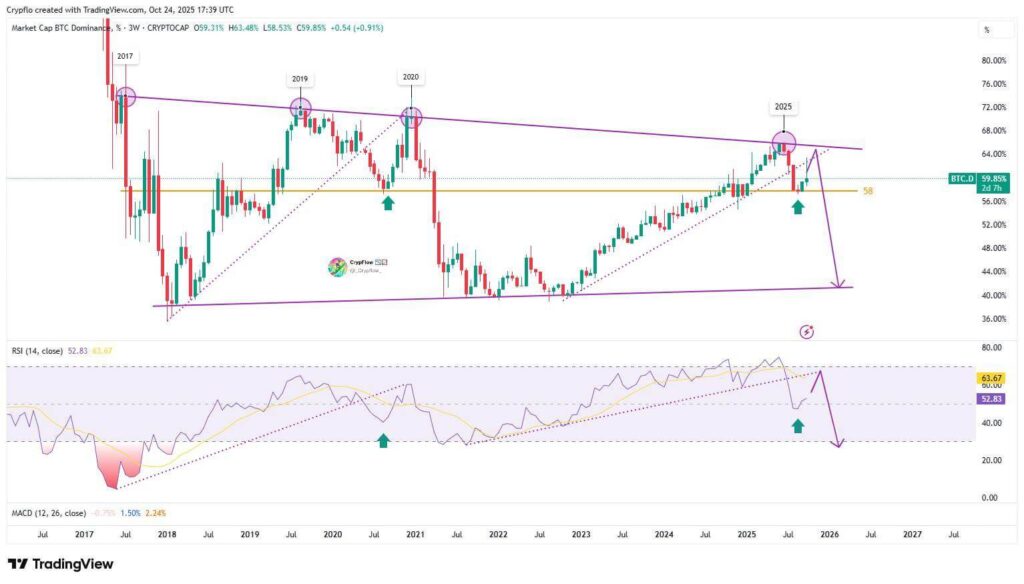Bitcoin dominance is approaching a critical 58% support level, signaling potential for an altseason if it breaks, as historical patterns suggest capital rotation to altcoins. Analysts observe weakening momentum indicators that could drive dominance down to 44% by mid-2026.
-
Bitcoin dominance rejected at 64% and now tests 58% support, a zone linked to past altcoin surges.
-
The 58% level has historically delayed breakdowns, mirroring setups that triggered significant altcoin rallies in previous cycles.
-
RSI and MACD indicators reveal declining momentum, with projections pointing to a dominance drop toward 44% by mid-2026 based on cycle analysis.
Bitcoin dominance nears 58% support amid signs of weakness, hinting at an impending altseason. Discover key indicators and historical insights driving this shift in crypto markets today.
What is Bitcoin Dominance and How Does the 58% Support Level Impact Altseason?
Bitcoin dominance measures the percentage of Bitcoin’s market capitalization relative to the total cryptocurrency market, serving as a key indicator of capital allocation in the crypto space. Currently hovering around 59.85%, it is retesting the pivotal 58% support level, which has in past cycles marked the onset of declines leading to altseason—periods where alternative cryptocurrencies outperform Bitcoin. This level’s potential breach could accelerate capital flows into altcoins, based on observed historical correlations from 2017, 2019, and 2020 cycles.
Why is the Rejection from 64% Significant for Current Market Trends?
The recent rejection of Bitcoin dominance from the 64% resistance zone, aligned with a descending trendline connecting major cycle peaks, underscores building pressure for a downturn. Analyst Crypto Flow, via a post on X, highlighted that this 58% support has repeatedly postponed breakdowns, yet its persistence in earlier periods—such as 2017 and 2019—ultimately gave way to sharp drops, enabling altcoins to capture market share rapidly. Historical data indicates that once breached, dominance often falls toward the 40-44% range within months, fostering what traders describe as a “true altseason.” Current patterns closely resemble these precedents, with the metric forming a long upper wick at 64%, a classic sign of exhaustion.

Source: CryptoFlow on X
Crypto Flow further noted surprise at the 58% level holding firm again, contrary to expectations for the current cycle, prompting a reassessment of short-term dominance extensions before an inevitable decline. Supporting this, the chart’s structure shows consistent rejections from similar highs, each preceding multi-month retracements. For instance, in the 2020 cycle, a break below 58% correlated with altcoin market caps expanding by over 300% in the following quarter, per data from market analytics platforms.
Frequently Asked Questions
What Happens if Bitcoin Dominance Breaks Below 58% Support?
If Bitcoin dominance breaks below 58%, it could initiate a rapid decline toward 44%, historically triggering altseason as investors rotate capital into altcoins. This pattern, observed in multiple cycles, often results in altcoin gains of 200-500% within weeks, based on past market data and analyst observations.
Is Altseason Likely in the Near Future Based on Current Indicators?
Current technical indicators like a weakening RSI at 52.83 and negative MACD at -0.75% suggest diminishing Bitcoin dominance strength, pointing toward an altseason. Analysts such as CryptoBullet remain optimistic, noting the macro setup favors altcoin rallies once support fails, aligning with natural cycle progressions for voice-activated searches on market trends.
Key Takeaways
- Critical Support Test: The 58% level for Bitcoin dominance has held multiple times, but historical breaks have always led to substantial altcoin outperformance.
- Weakening Momentum: RSI below its trendline and cooling MACD confirm fading upward pressure, setting the stage for potential dominance erosion.
- Cycle Projection: A breakdown could see dominance at 44% by mid-2026; monitor closely and consider diversifying into altcoins for portfolio balance.
Conclusion
Bitcoin dominance’s approach to the 58% support level, amid rejecting higher resistances and faltering indicators, echoes patterns that have preceded altseasons in prior cycles. With expert insights from analysts like Crypto Flow and CryptoBullet emphasizing the macro bullishness for altcoins, the crypto market stands at a potential inflection point. Stay informed on these developments, as a confirmed break could usher in dynamic opportunities—position your strategy accordingly for the evolving landscape.
Bitcoin’s market dominance, a cornerstone metric in cryptocurrency analysis, continues to exhibit signs of vulnerability after its latest rejection from the 64% threshold. This upper level, tied to a long-term descending trendline spanning peaks from 2017 through 2025, acts as a barrier that, once overcome in the past, has funneled liquidity toward alternative digital assets. As dominance lingers near 59.85%, the focus sharpens on the 58% support, a threshold with proven significance in dictating market rotations.
Delving deeper into the dynamics, the 58% mark has not only delayed declines but also served as a launchpad for explosive altcoin growth. In previous instances, such as the 2017 bull run, a breach here correlated with Bitcoin’s share plummeting to around 35%, while the broader altcoin sector ballooned in value. Crypto Flow’s analysis on X captures this sentiment, pointing out that the current postponement of a breakdown mirrors setups that eventually yielded to “true altseason” phases, where altcoins dominated headlines and returns.
Technical nuances further bolster this narrative. The formation of a pronounced upper wick at 64% signals seller intervention at elevated levels, a precursor to reversals observed in 2019 and 2020. Should support at 58% falter, projections align with a trajectory toward 44%, a level that has marked cycle lows and invited aggressive buying in altcoins. This isn’t mere speculation; it’s rooted in repeatable cycle behaviors documented across years of market data.
Turning to momentum tools, the Relative Strength Index (RSI) has breached its ascending trendline, dipping to 52.83 from a high of 63.67—a clear divergence indicating buyer fatigue. Complementing this, the Moving Average Convergence Divergence (MACD) histogram’s shift to -0.75% reflects a slowdown in bullish drive following an overbought stretch. These readings, consistent with tops in prior cycles, suggest the dominance rally may be nearing exhaustion, paving the way for reversion.
Analyst CryptoBullet echoes this optimism for altseason, affirming that the broader Bitcoin dominance chart reinforces belief in an upcoming shift. Such endorsements from seasoned observers add credibility, drawing on years of pattern recognition in volatile markets. The cyclical nature of crypto, influenced by halving events and macroeconomic factors, supports the view that capital rotation remains a natural progression.
Looking ahead, the months could see either a prolonged hold above 58%, extending Bitcoin’s lead, or a decisive break accelerating altcoin momentum. Historical precedents lean toward the latter in similar configurations, with dominance retracing sharply once momentum flips. Traders are advised to exercise caution, as rapid changes in this metric can amplify volatility across the ecosystem. By understanding these signals, investors can better navigate the potential onset of altseason, optimizing exposure in a maturing market.





